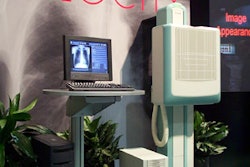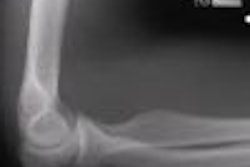BOSTON - Radiology IT managers would be the first to say there's no such thing as an error-proof system. Although digital x-ray acquisition technologies are more forgiving of inappropriate exposure factors than conventional film-screen radiography, digital x-ray can suffer from the same general kinds of technical errors that plague its hard-copy forbears.
(For the purposes of this article, "DR" refers to both flat-panel and computed radiography digital acquisition technologies.)
"The unfortunate truth is that DR is subject to many of the same interferences as conventional radiography, plus many new interferences that are a direct result of the way the DR image is generated," said Charles Willis, Ph.D., during a talk Monday at the Symposium for Computer Applications in Radiology (SCAR).
Willis, who is a radiation physicist at the Baylor College of Medicine Texas Children’s Hospital in Houston, explained the types of errors that can result from the misuse of DR modalities, and offered suggestions for implementing a quality control (QC) program to minimize their occurrence.
A quality x-ray image depends on a number of specific techniques, he said. These include the use of the correct kVp and mAs, an adequate source-to-image distance (SID), collimation, central ray alignment, and proper positioning of the detector and the patient for the specific anatomy being examined.
If the image is underexposed or the scatter detection grid is misaligned, too few x-rays will produce a noisy image. If too many x-rays are used, the patient is exposed to unnecessary radiation, and the resulting image may also be of poor quality.
"Even though DR is more tolerant of incorrect exposure factor selection, it cannot make up for extra noise, loss in subject contrast, and signal out of its range of adjustment," Willis said.
To create quality images, a DR device must be properly calibrated, configured, maintained, and operated, Willis said. This is achieved by making sure the DR system is properly configured with the most up-to-date version of the software consistent with the versions and settings in operation on other DR systems in use at an institution.
For calibration of the equipment, Willis suggested the use of the DICOM Part 14 Grayscale Display Function for use on the hard-copy devices, soft-copy devices, and QC devices. In addition, the same vintage of imaging plates (IPs) on computed radiography systems should be used throughout a healthcare enterprise.
"Achieving the same level of image quality across an enterprise will be difficult, if not impossible, if you mix and match multiyear IPs," he said.
Scheduled and unscheduled maintenance, occurring as the result of an unexpected malfunction, should be done in a thorough and timely manner, including reporting and documenting cleaning and repairs. Such repairs should never be attempted by personnel other than manufacturer-certified service engineers, he said.
"There are two very dangerous sorts of people in a radiology department: a technologist with a toolkit and a physicist with his hands out of his pockets," Willis observed.
Technologist training on DR features and functions is critical for achieving good images consistently, he said. Additional education beyond what might be delivered by a vendor in applications training will be needed to comply with institution-specific modality parameters.
In addition to establishing the correct kVp, mAs, and SID for exams, image processing is a parameter that should be determined and set by a facility. Willis noted that all DR systems have extremely wide latitude, which means that for a display system with a relatively narrow dynamic range, DR images have extremely low contrast. Image processing is used to maximize contrast on the part of the image containing the relevant clinical information.
"The DR system locates either the boundary of collimation or the border of the projected anatomy and disregards details outside this boundary. Errors in collimation can cause mistakes in the detection of this boundary, with a dramatic loss in image contrast," he said.
Another common type of image processing is the kind that is applied to customize contrast in the region of interest for the exam. This is achieved by modifying the image to enhance the contrast and sharpness of some features while compromising the contrast and sharpness of others, as well as modifying the image to make it appear more film-like, said Willis.
This type of image processing, which is usually applied in ways specific to the anatomy being examined, can also lead to errors.
"If a PA chest exam is performed and the technologist inadvertently selects abdomen as an image processing type, the image quality of the study may be compromised," he said.
Although image processing is one of the great benefits of DR modalities, it is not a panacea for sloppy radiographic practices.
"Inappropriate image processing cannot compensate for inappropriate radiographic technique, nor can it compensate for the poor calibration or poor maintenance of DR equipment," Willis said.
By Jonathan S. BatchelorAuntMinnie.com staff writer
June 10, 2003
Related Reading
Chest CR outperforms screen-film catheter localization, May 26, 2003
Filmless ED can open the door for enterprise-wide PACS, May 9, 2003
DR permits lower chest dose than film or CR, January 30, 2003
Bigger not necessarily better for digital chest x-ray matrix, January 15, 2002
Copyright © 2003 AuntMinnie.com



















